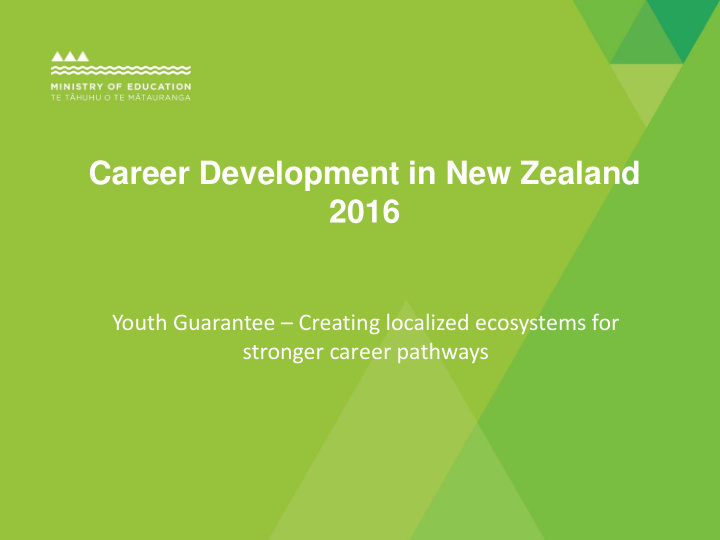



Career Development in New Zealand 2016 Youth Guarantee – Creating localized ecosystems for stronger career pathways
VOCATIONAL SKILLS FOR PATHWAYS EMPLOYMENT BUILDING LOCAL CRUCIAL TO NZ TALENT VS ECONOMIC GROWTH IMMIGRATION GROWING SUPPLYOF SKILLS THROUGH DEVELOPING SKILLS PATHWAYS
A responsive curriculum, effective teaching and opportunity to learn Each Board of Trustees is required to develop and implement a curriculum offering that is underpinned by key principles. At the senior secondary level, a coherent, future focussed curriculum is an important principle providing all students with a broad education. One that is learner centred, makes links across learning areas and opens up pathways to educational opportunities beyond school. Source: NZ Curriculum – Requirements for Boards of Trustees
Significant Economic and Employment Growth Opportunities (Auckland) by Sector • ICT • Construction and Infrastructure • Food and Beverage high end manufacturing • Tourism • Health Evidence (from IRD tax returns) show that people with a minimum of a Level 4 qualification are able to sustain a reasonable standard of income in a changing labour market The level 4 qualification maybe gained in an education, training or industry setting
Using the Vocational Pathways for Programme Design Contextualised Learning
NCEA Level 2 with a Vocational Pathways Award Student record of achievement • Aligning learning with needs of sectors • Relevant for employers, students, communities • Creating options for all • Vocation – not just trades • Curriculum design tool • Clear learning pathways • Flexible and adaptable • Learner centred
Coherent programmes of learning Science, Sector related learning On the job learning Maths, English etc NZ Curriculum Industry Related Work Experience Key C’s Core C’s Vocational Pathways Gateway, STAR, NZ Curriculum Level 7 Level 2 NZQF Level 2 Achievement Unit Standards Unit Standards Standards
Level 3 – the bridge to where? • Previously, Level 3 was primarily used as preparation for a university destination • Yet…. only 30% of school leavers go directly to university… what about the other 70%? • How much of an untapped market is this? • 3+2 model – partnerships with industry; • Why? What can this look like?
For Every 100 students that achieve NCEA Level 2 … 23% of all school leavers don’t get into this picture! They have already gone ... 56 23 21 REMAIN IN SCHOOL & REMAIN IN SCHOOL & DON’T REMAIN IN SCHOOL LEAVE WITH LEVEL 3 LEAVE WITH LEVEL 2 & LEAVE WITH LEVEL 2 DESTINATIONS? DESTINATIONS? DESTINATIONS?
Skills pathways – what do we mean? • Sector specific / region specific • With L2 achievement rising, more students are being retained at Year 13, Level 3. Their curriculum needs are not being met by a traditional offering What are pre-requisites for entry into next options? Primary Industries 3 + 2 model = NCEA L3 60 credits (School Destination Data) Agri-science L6 Food Food Business Technology Studies Agribusiness Management - NZ Diploma L5 NZC Maths Farming Science etc. Agriculture - National Certificate L4 Dairy – Industry Training L4
Recommend
More recommend